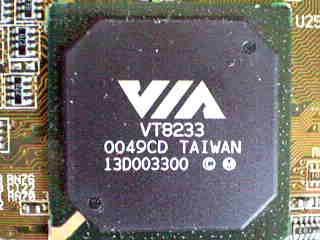ASUS CUV266 Socket-370 Apollo Pro 266 ATX
by Mike Andrawes on April 18, 2001 12:50 AM EST- Posted in
- Motherboards
The New Choice for Pentium III: Apollo Pro 266
The VIA 8633 North Bridge provides official support for 133MHz FSB Pentium III’s as well as DDR SDRAM and AGP 4X. One big advantage of the Apollo Pro 266 over the i815 is that its 8633 North Bridge supports a full 4GB of DDR SDRAM, rather than the i815’s paltry 512MB. Unfortunately, since 184-pin DDR SDRAM is still in the early stage compared to the traditional 168-pin SDRAM, large capacity modules are not readily available at the moment. With the common 128MB and 256MB modules that are available, packing 4GB of memory on Apollo Pro 266 motherboard is simply not possible. ASUS did include three DDR DIMM slots, so you should be able to install a total of 768MB memory. With 512MB modules on the way, 1.5GB should be easily reachable as well.
Just like all the other Apollo Pro 266 boards we’ve seen, the CUV266 allows you to run the CPU and the memory asynchronously. That’s good news because now you can take advantage of PC2100 DDR SDRAM using a 100MHz FSB Pentium III. However, as we've noticed in recent investigations, running your FSB and memory buses asynchronously can cause a significant memory latency penalty which could negate any performance gains you'd get from the higher bandwidth memory.
Speaking of memory, because of VIA's partnership with Nanya, ASUS is able to bundle a 128MB PC2100 DDR SDRAM stick using Nanya chips with the CUV266. ASUS has informed us that this is how all CUV266s will ship, however they may have a version without the bundled DDR SDRAM available in the future. It seems like this is an attempt by VIA to mimic Intel in their bundling of RDRAM with Pentium 4 processors.
The 8633 North Bridge also controls the AGP bus, and to ensure compatibility with all video cards on the market, ASUS went ahead and included an AGP Pro slot. Although there aren’t many video cards that require the added power supplied by AGP Pro. The AGP Pro slot is not keyed for 1.5V or 3.3V devices, so you should have no problem installing any AGP card.

VIA’s 8233 South Bridge
The Apollo Pro 266 is also the first demonstration of VIA”s V-link, a dedicated channel between the 8633 North Bridge and the 8233 South Bridge rather than just using the PCI bus to connect the two. It’s very similar to Intel Hub Architecture (IHA) and moves the PCI bus interface to the South Bridge. Besides the PCI interface, the 8233 South Bridge also provides two Ultra ATA 100 channels supporting up to four IDE devices (two per channel) and three USB root hubs (6 USB ports total).
The two traditional USB ports are still located at the back, within the ATX I/O panel, while two extra USB headers are found on the left side of the board. You will need to use an USB bracket to enable the two USB ports available from each header, so you will need two brackets to take advantage of all four USB ports. In the past, ASUS has included at least one USB header, although none with this early evaluation sample.

Headers for the second and third USB root hub.
The 5/1/0/1 (PCI/AGP/ISA/ACR) expansion slot configuration has been spotted on several Apollo Pro 266 motherboards, which should be enough for most system configurations, although six PCI slots with or without the ACR slot would be even better in the minds of most AnandTech readers.
ASUS has always been one of the biggest OEM suppliers in the market, and that’s exactly why they continue to include an ACR slot. ACR is VIA’s answer to the Intel’s CNR slot, and its advantage is that the slot itself is actually an inverted PCI slot, so manufacturers do not have to produce a special slot design and thus reducing the cost. Older AMR cards can work in an ACR slot as well.
In terms of on-board audio, ASUS went a step beyond the common AC’97 host-based CODECs we usually see and made the C-Media CMI8738 hardware-based sound chip optional. For better audio , especially in games, we still recommend something like a Creative Labs Sound Blaster Live!

C-Media on-board audio.











0 Comments
View All Comments